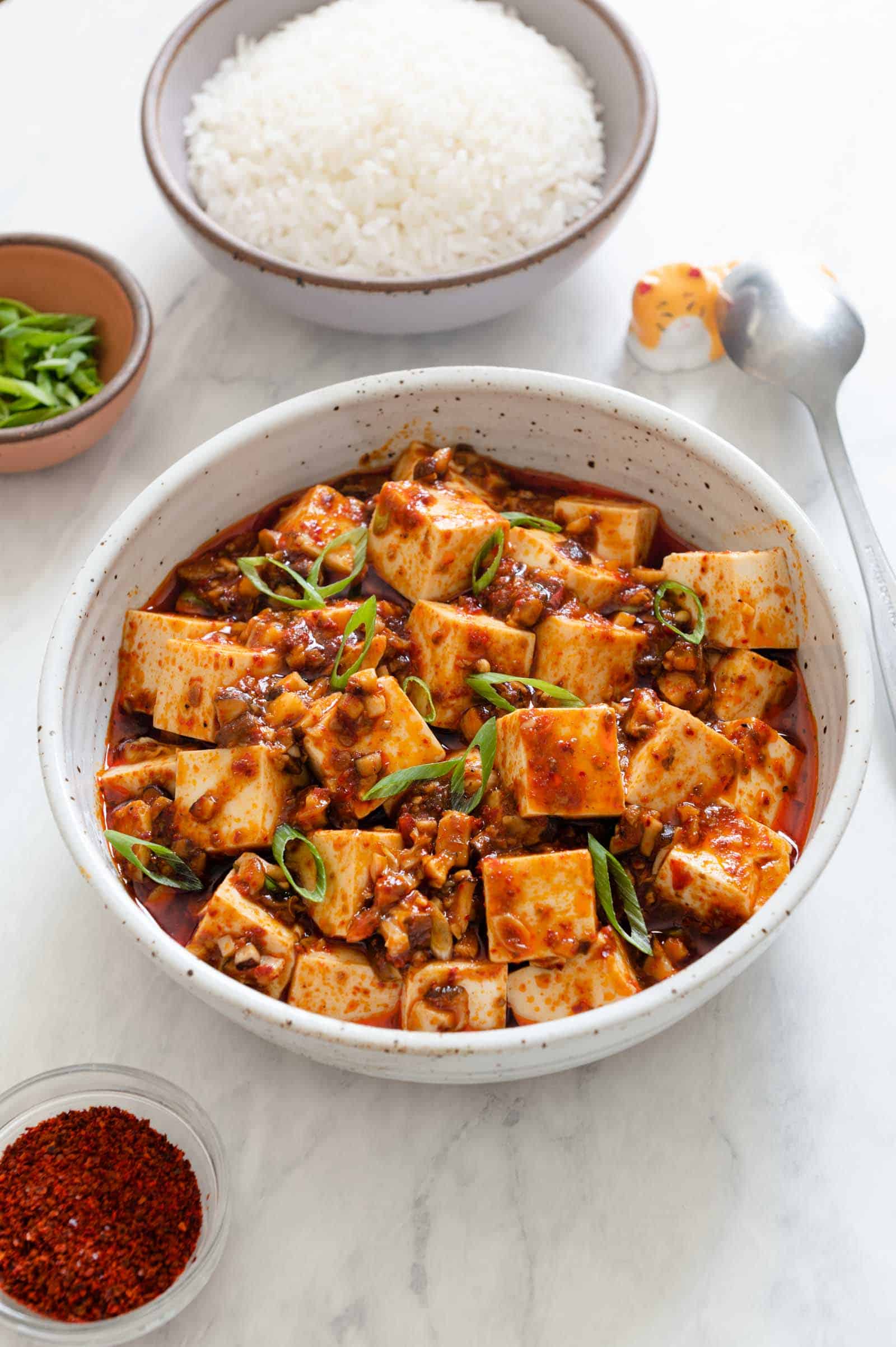
WHAT IS MAPO TOFU (麻婆豆腐)?
Mapo tofu (pronounced mapo doufu in Mandarin), originates from China’s Sichuan Province. It’s a dish made with pork mince and tofu bathed in a spicy sauce. According to legend, an old lady from Sichuan, who had pock marks on her face, was known for serving a delicious tofu dish. Over time, her special dish came to be known as 麻婆豆腐, literally “pock-marked old lady’s tofu.” You can read more about the history of the dish in Fuchsia Dunlop’s article on The Guardian.
WHAT IS MALA SPICE?
The key to good mapo tofu is the mala spice provided by red Sichuan peppercorns (大紅袍花椒). Mapo tofu was my introduction to the tongue numbing sensation of Sichuan peppercorns. When you bite into one of those peppercorns, you’ll feel a slight tingling on the tip of your tongue. In a few short moments, the tingling feeling transitions into a slight numbing sensation. It is a strangely addictive experience that is common when eating Sichuan cooking.
The phrase that describes the unique spice sensation associated with Sichuan cuisine is called mala (麻辣). In Chinese, “麻” means “numb” and “辣” means “spicy.” The combination of Sichuan peppercorns and chili flakes provide the distinctive mala flavor in Sichuan-style cooking.
HOW TO MAKE VEGAN MAPO TOFU
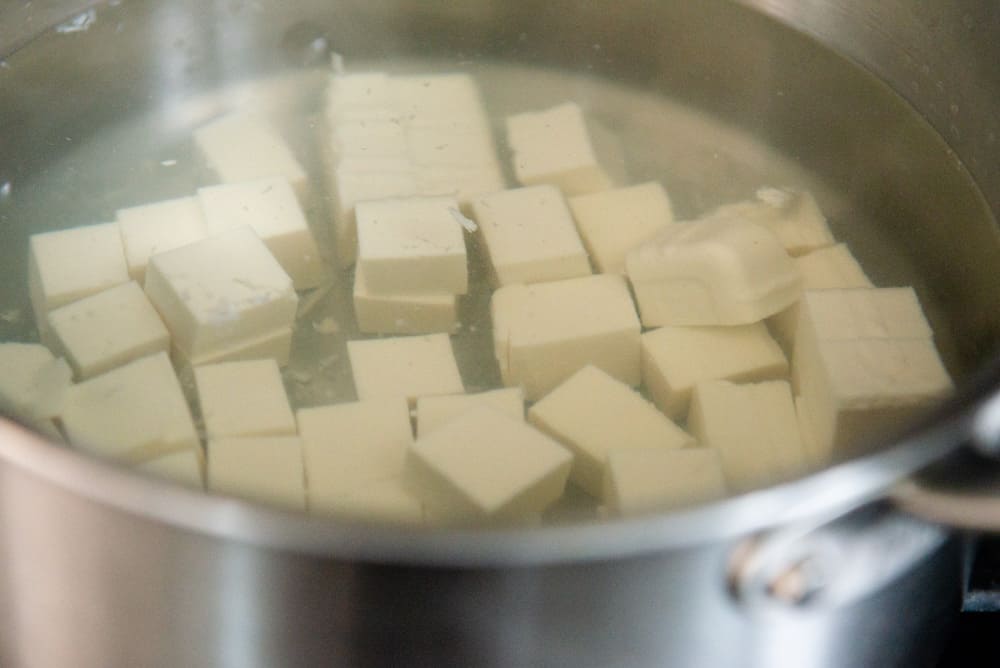
PREPARE THE TOFU
I prefer mapo tofu when made with softer, smoother tofu. If you are buying refrigerated tofu that comes in plastic rectangular containers, choose the variety labeled “silken” or “soft” tofu.
If you are buying small bricks of fresh tofu sold in bulk at an Asian supermarket, choose the tofu that is less firm. The tofu bricks are slightly firmer than silken tofu, but they work well for this recipe. Chop the tofu into 3/4-inch cubes.
One thing to note about cooking with silken tofu is that they crumble very easily. As a result, you won’t want to toss them in the wok too much. To heat the tofu thoroughly, boil some water with a bit of salt. Then, turn off the heat and soak the tofu cubes in hot water while you prepare the sauce.

A VEGAN VERSION
Typically, mapo tofu is made with pork mince for umami flavor. In this vegan mapo tofu recipe, I omitted the pork and used finely diced shiitake mushrooms instead. If you don’t like mushrooms, you can leave it out. Alternatively, you can substitute the mushrooms with 2/3 cup of finely diced sweet bell peppers or jicama for crunch.
Stir fry the shiitake mushrooms with 1 tablespoon of oil for about 2 minutes. Then, dish up the mushrooms.
INGREDIENTS FOR SAUCE

Doubanjiang (豆瓣醬): This is a Sichuan-style chili sauce made with fermented broad beans/fava beans. The sauce is quite salty, which is why I don’t add additional salt to the sauce. In a previous iteration of the recipe, I added another tablespoon of black bean and garlic sauce (蒜蓉豆豉醬). Having cooked this dish again over the past few years, I don’t find the addition necessary and makes the dish even more salty. That’s why I’ve omitted the sauce in this newer version.
You can find doubanjiang in Asian grocery stores, especially ones that sell Chinese ingredients. If you don’t have easy access to an Asian grocer, you can find it on Amazon (affiliate link) or Asian online stores like Yamibuy or Weee!
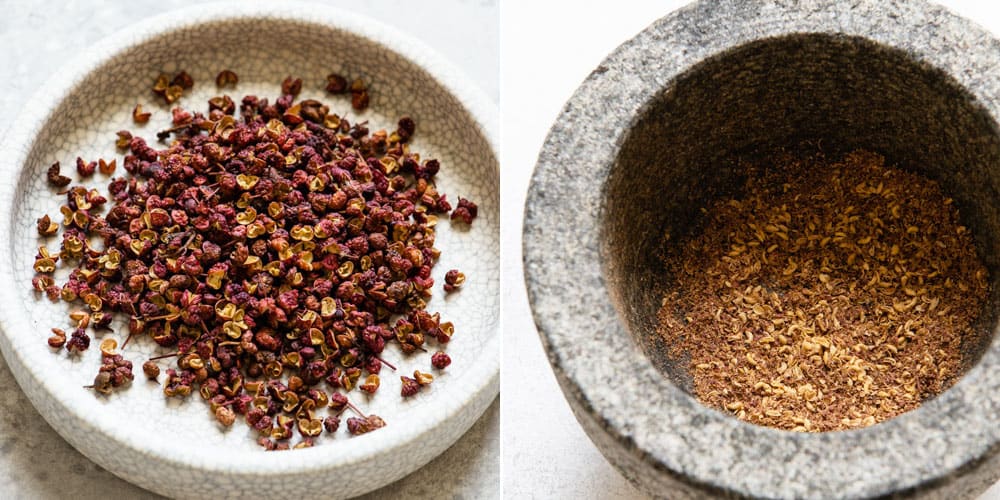
Red Sichuan Peppercorn: Measure out 3 to 4 teaspoons of the peppercorns and grind it with a mortar and pestle or with a spice grinder. If you’re using a mortar and pestle, you’ll find that the husks won’t break down entirely. Because this recipe uses a considerable amount of Sichuan peppercorns, the firm texture of the husks can get annoying as you eat the tofu.
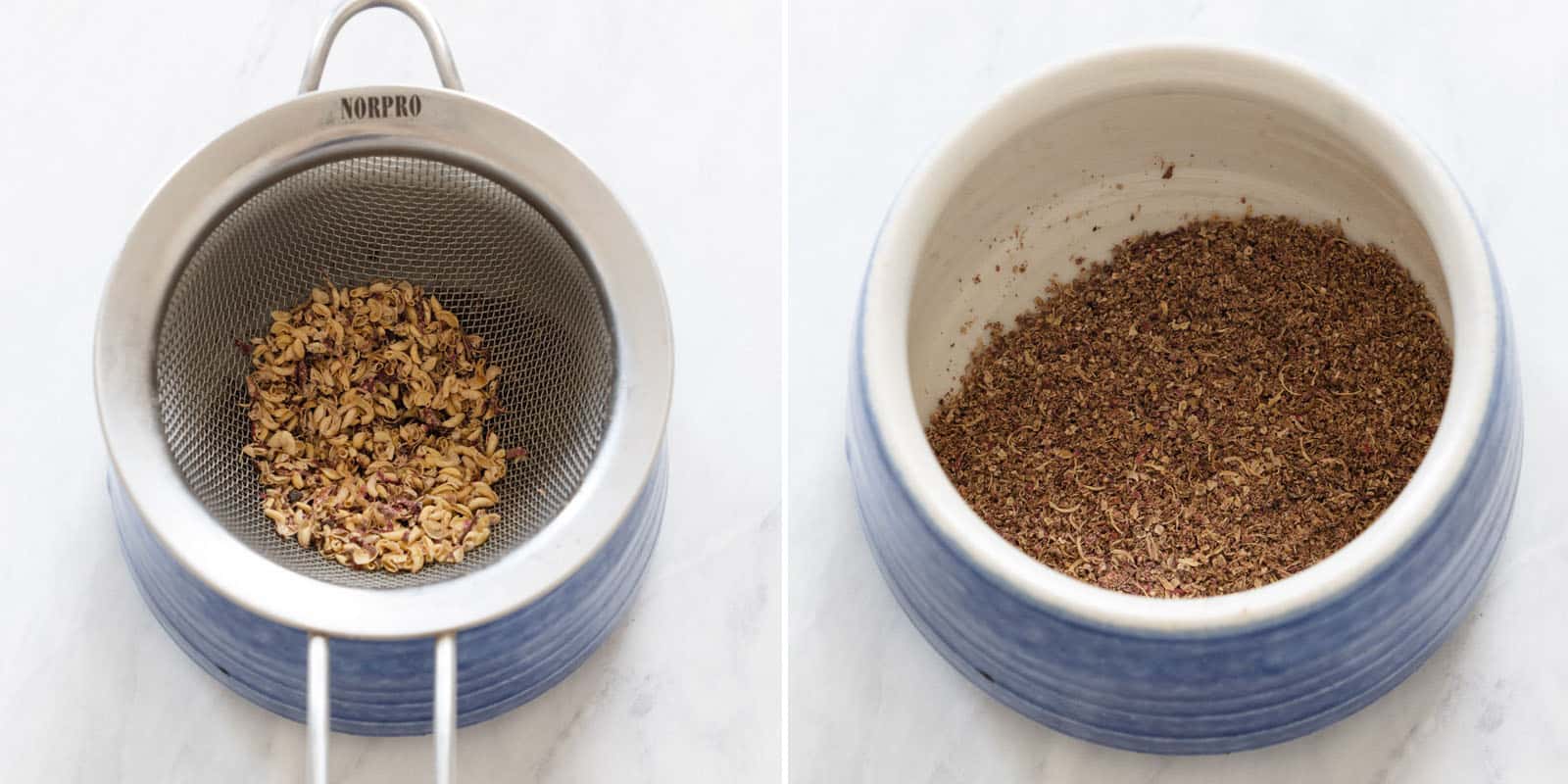
I recommend sifting the ground peppercorns through a fine mesh to sift out the husks. Grind 3 teaspoons (or 1 tablespoon) of the peppercorns if you want some spicy tingle in the dish; grind 4 teaspoons if you want more.
If you use a spice grinder, I recommend grinding a few tablespoons of the peppercorns at once. I find grinders don’t work as well when you’re grinding very low quantities of something. Then, sift out the husks (yes, there’ll still be some). Finally, measure out 1 1/2 teaspoons of the sifted peppercorns for the dish; use 2 teaspoons if you want more spice.
Garlic & Ginger: I like using minced garlic and ginger for aromatic spice. The recipe uses 1 tablespoon of minced ginger. If you want a more spicy dish, you can add 2 to 3 more teaspoons of minced ginger.
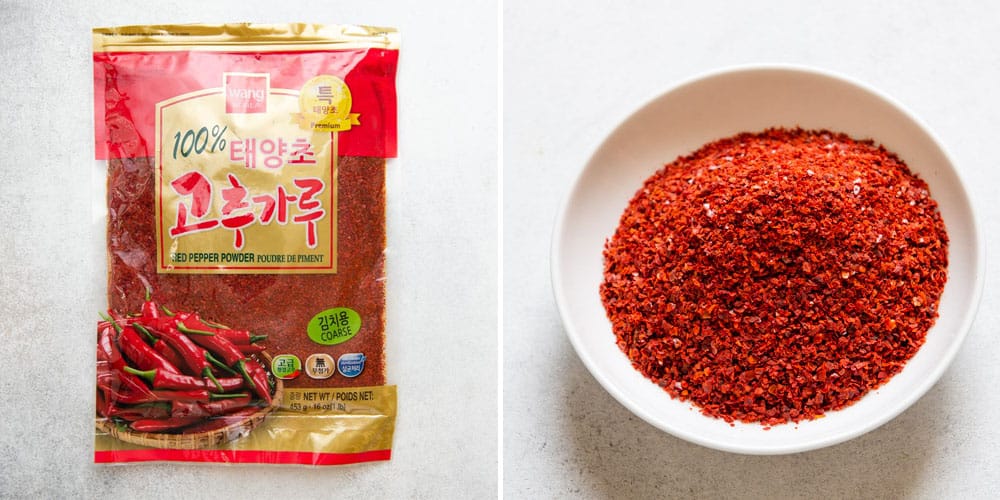
Chili Flakes: Usually, mapo tofu recipes use Chinese chili flakes. In this recipe, I add gochugaru, Korean red pepper flakes, because I love their lightly smoky flavor and the bright red color they add to the dish. The spice level of gochugaru is generally pretty mild. Feel free to use less if you are more spice averse.
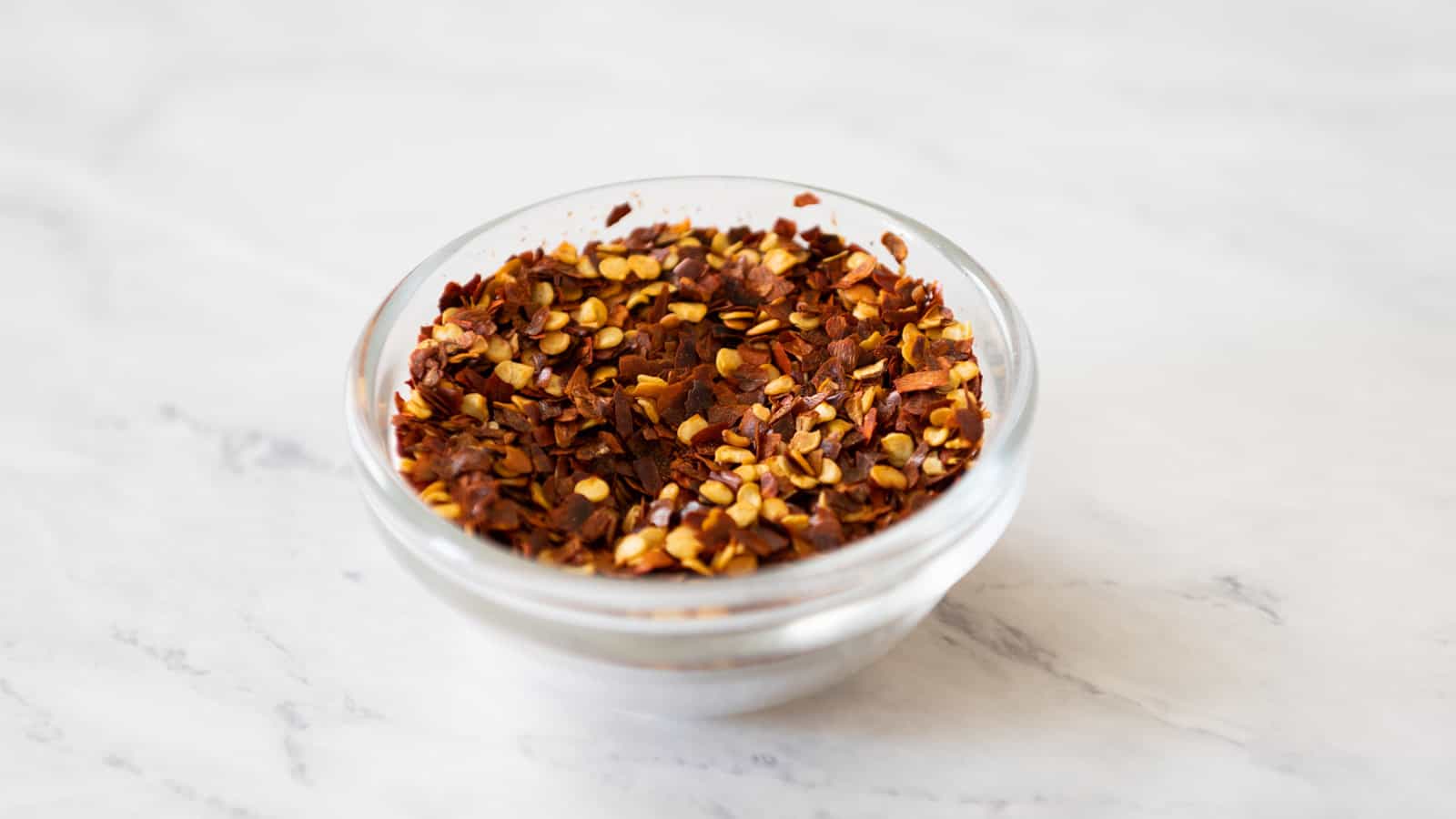
Substitutions for Gochugaru: You can use chili flakes like the ones in the photo above. These chili flakes with seeds can be much spicier than gochugaru. If you taste some of it and detect a strong heat at the tip of your tongue, I’d start with 3/4 teaspoon of the chili flakes. Add more if you want more spice.
Sugar: I add a little sugar in the sauce to balance the salty flavor of the doubanjiang.
Cornstarch slurry: You’ll also need 1/2 cup of water mixed with 1 teaspoon of cornstarch (the cornstarch acts as a thickener). The cornstarch can be replaced with tapioca starch.
Fermented Black Beans: Many traditional mapo tofu recipes use fermented black beans (豆豉) to give the dish more flavor. In my original recipe, I used 1 tablespoon of black bean and garlic sauce (蒜蓉豆豉醬) because it is more readily available than fermented black beans. Since I published the recipe, I’ve made the mapo tofu without the black bean and garlic sauce, and I didn’t miss it. That’s why I decided to omit it from the recipe. You can add 1 or 2 teaspoons of black bean and garlic sauce to the dish, if you like.
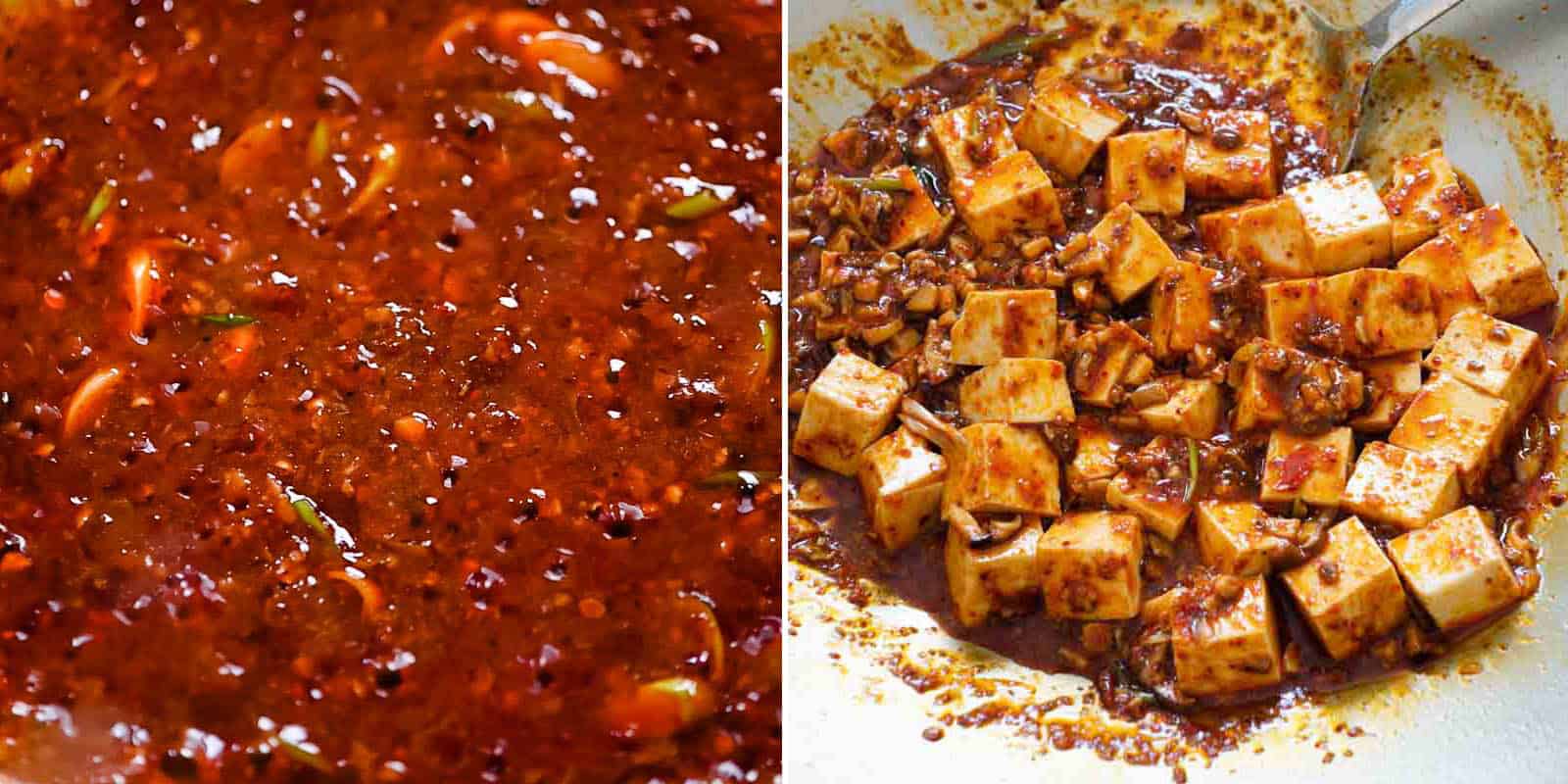
PREPARE THE SAUCE
Heat 2 tablespoons of oil on medium heat. Next, add the garlic and ginger and sauté for 30 seconds. Then, add the doubanjiang and sauté for another 30 seconds. Add the ground Sichuan peppercorn, gochugaru (or chili flakes), and sugar and stir together. Finally, add the cornstarch slurry and simmer the sauce for 2 to 3 minutes.
In this recipe, I slice a stalk of scallions for the sauce and the garnish. I add the white and light green parts to the sauce as it simmers, and I use the dark green parts as garnish at the end.
MIX THE SAUCE WITH MUSHROOMS & TOFU
Add the sautéed mushrooms to the wok. Using a skimmer or a slotted spoon, transfer the warmed tofu to the wok as well. Then, carefully toss everything together. The tofu is very delicate and can break apart easily, so be careful.
Serve the mapo tofu in a bowl. Drizzle the tofu with a bit of sesame oil and garnish with the sliced scallions.
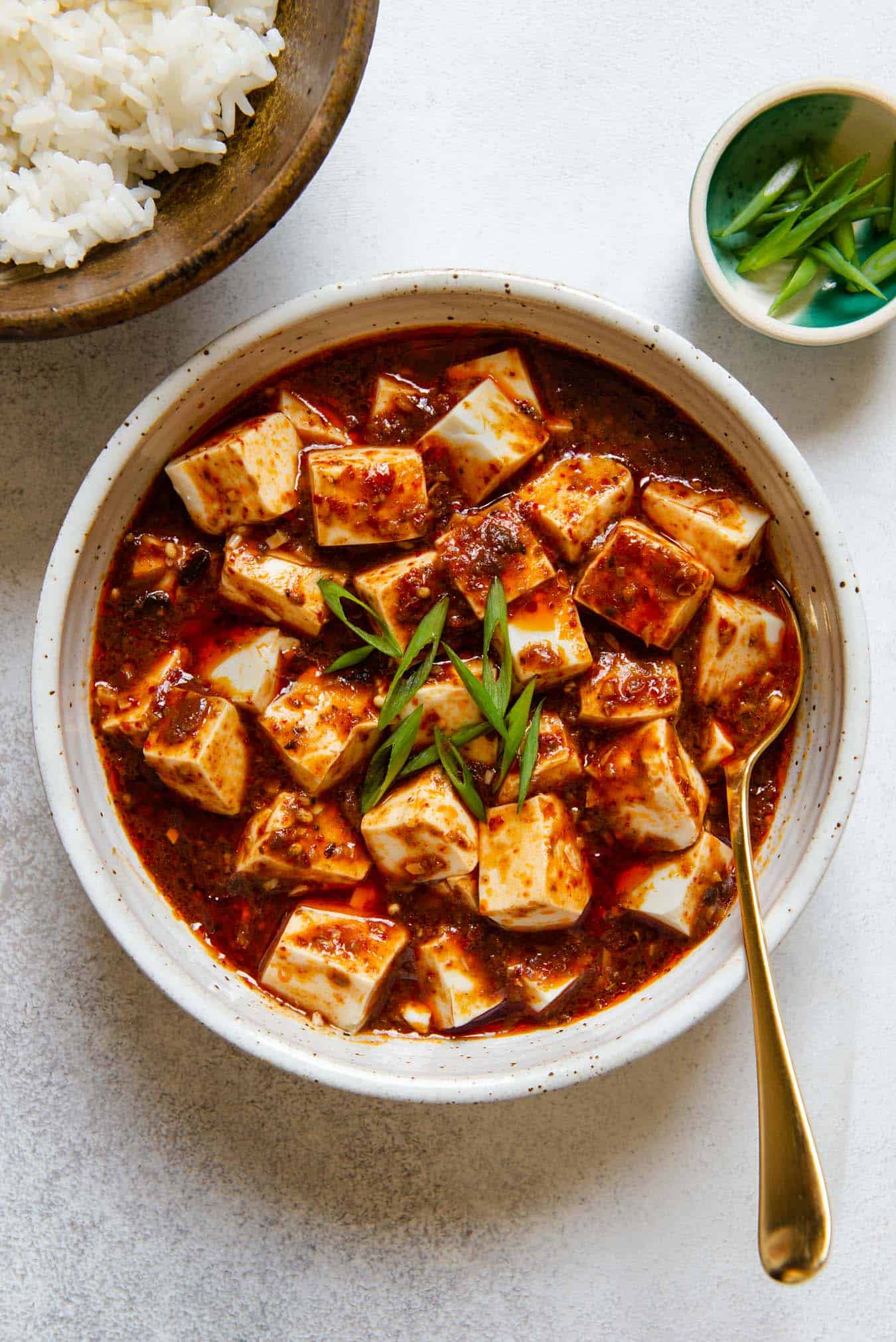
WHAT TO SERVE WITH MAPO TOFU
- Rice! Try Jasmine Rice, Brown Rice, or Coconut Rice
- Chinese Smashed Cucumber Salad
- Roasted Asparagus
- Chinese Garlic Green Beans
- Green Papaya Salad
Vegan Mapo Tofu (素食麻婆豆腐)
Ingredients
Tofu
- 1 pound (455g) soft or silken tofu, (see note 1)
- 8 cups (1.9L) water
- 2 teaspoons (12g) table or sea salt
Mushrooms
- 1 tablespoon neutral oil (vegetable, canola, safflower, etc.)
- 1 cup (65g) finely diced shiitake mushrooms
Sauce
- 3 to 4 teaspoons Sichuan peppercorn, depending on desired spice level
- 1 teaspoon (12g) cornstarch or tapioca starch
- 1/2 cup (118ml) water
- 2 tablespoons neutral oil (vegetable, canola, safflower, etc.)
- 2 tablespoons (15g) minced garlic
- 1 tablespoon (7g) minced ginger
- 2 tablespoons (40g) doubanjiang, (see note 2)
- 1 1/2 tablespoons (10g) gochugaru, (see note see note 3 for substitutions)
- 1/2 teaspoon (2g) sugar
- 1 stalk of scallions, sliced, lighter pieces and dark green pieces separated
- drizzle of sesame oil
Instructions
Prepare the Tofu
- Drain the block of tofu and remove it from the package. Cut the tofu into 3/4-inch cubes.
- Add 8 cups of water and 2 teaspoons salt to a saucepan and bring it to boil. Remove the saucepan from heat.
- Using a skimmer or slotted spoon, carefully lower the tofu cubes into the hot water. Let the tofu sit in hot water as you prepare the sauce.
Cook Mushrooms
- Heat 1 tablespoon of oil in a wok over medium heat. Add the mushrooms and cook for about 2 minutes, stirring frequently.
- Transfer the mushrooms to a bowl and turn off the heat.
Prepare the Sauce
- Grind the Sichuan peppercorns with a mortar and pestle or spice grinder. Sift the ground peppercorns through a fine mesh to sift out the tough husks. Discard the tough husks (see note 4).
- Add ½ cup of water and 1 teaspoon cornstarch to a small bowl and stir to combine. Set it aside.
- Heat 2 tablespoons of oil on medium-high heat. Add the garlic and ginger and sauté for 30 seconds. Then, add the doubanjiang and sauté for another 30 seconds. Add the ground Sichuan peppercorn, gochugaru (or other chili flakes), and sugar and stir together. Finally, give the cornstarch slurry a stir again and add to the wok (see note 5). Add the white and light green parts of the scallion. Let the sauce simmer for 2 minutes.
Mix Sauce with Mushrooms & Tofu
- Add the sautéed mushrooms to the wok. Using a skimmer or a slotted spoon, transfer the warmed tofu to the wok as well. Then, carefully toss everything together. The tofu is very delicate and can break apart easily, so be careful.
- Transfer the mapo tofu to a serving bowl.
- Drizzle a tiny bit of sesame oil over the tofu. Garnish the tofu with the dark green parts of the scallion. Serve with jasmine rice or brown rice.
Notes
- Some soft or silken tofu comes in 14-ounce packages, which also works for this recipe.
- You can find doubanjiang in Asian grocery stores, especially ones that sell Chinese ingredients. If you don’t have easy access to an Asian grocer, you can find it on Amazon or Asian online stores like Yamibuy or Weee! You can use any leftover doubanjiang in these recipes: Spicy Eggplant Stir Fry, Spicy Peanut Noodles.
- I prefer using gochugaru because it gives the sauce a nice red color and a subtle smoky flavor. You can use Chinese-style chili flakes or even red pepper flakes that you can find in grocery stores. Note that different chili flakes vary in their level of spice! If you’re using a very mildly spiced chili flake, use 1 tablespoon and add more if desired. Chili flakes from the supermarket that are sold with the seeds tend to be spicier. If you’re using that type of chili flake or any spicy chili flake, start with 3/4 teaspoon of the flakes and add more if you want more spice.
- In a previous iteration of the recipe, I didn’t sift out the husks of the peppercorns. A few of my friends told me they didn’t like the tough texture of the husks. That’s why I’ve added the step of sifting the ground peppercorns. When you sift out the husks, you lose about half of the volume of the peppercorns. That’s why in this new version of the recipe, I’m using slightly more Sichuan peppercorns to start.
- Cornstarch settles at the bottom very easily. That’s why you should stir the cornstarch before adding to the wok.
Nutrition
Note: This post was first published in October 2019. I have updated the post with more photos and altered the recipe, which I explain further in the recipe headnote.



Reiko says
I’m anxious to try this recipe since I have 3 containers of tofu (Costco sale). I’m just curious about what placing the tofu in hot water does. Does it firm up the tofu? I’m so glad I found you and your beautiful Mom. I used to live close by in Fair Oaks, CA. Also Lathrop, CA near Stockton. I know your mom likes visiting her friends there in Stockton to gather produce. I always get long winded on these foodie comments – I’ll let you know how the mapo tofu comes out. ????????
Lisa Lin says
Hi Reiko, I explain all this in the blog post (before the recipe)! Look for the heading “Preparing the Tofu.” Hope that answers your questions.
Nandita says
This was great! I’ve been searching for a veggie version of mapo forever. I’ve made this twice in the past week!
Mari says
I’m so glad someone made a vegetarian recipe!!! I’ve always just replaced the ground pork with mushroom, but there is always an obvious flavor component lacking. The adjustments to the bean paste amounts make this dish so perfect!!
Min says
Could you take a picture of the black bean sauce and doubanjiang labels? I would love to see which brands you use. I bought a couple but don’t know if there are better brands.., the last time I made mapo tofu with the ones I have, it didn’t taste good at all. Thanks!!!
Lisa Lin says
Hi Min, if you scroll through the post, there is a photo of the 2 sauces. It is the 3rd photo in this post.
Sophia says
I suppose people ought to know how much Sichuan peppercorn they can handle, but I made this dish, and it was inedible due to the amount and fact that the peppercorns were ground. I think it would have been helpful to note that people who are used to Americanized versions of Chinese food should probably seriously reduce that amount. It was a bummer, because my boyfriend and I had sat down to what we thought was going to be a nice dinner, and we couldn’t even eat two bites of the dish.
Lisa Lin says
Hi Sophia, did you use the full tablespoon of Sichuan peppercorns? In note 4 of my recipe, which is referenced in the ingredients list, I suggested using 2 teaspoons if you want less spice.
Manal says
Agreed. My family loves spicy food but this dish was too spicy to eat. I used 1.5 tablespoons and it was still too much.
JP says
> I used 1.5 tablespoons and it was still too much.
1.5 tablespoons = 4.5 teaspoons. No wonder why your dish was too spicy!
Shilpa says
WAY WAY too spicy, even with the reduced amount of peppercorns (2 tsp). I am sweating which is saying a lot because I am Indian and we eat pretty spicy food. Would appreciate any suggestions on what else I can make with the two sauces. I can’t handle making this again.
Payal says
Red peppercorns or any peppercorns can be a bit firey. I find as a general rule of thumb for any recipe is to gradually add any spice, especially if we are making it for the first time until the “to taste” level is reached. I keep tasting my dishes until I am sure it’s ok. As everyone has a different level of tolerance to spices as well.
Lauren says
This recipe has become a staple for us! I appreciate that it isn’t build around mushrooms. I use a lot less Sichuan peppercorn because I’m very sensitive to it and bump up the flavor with some laoganma to compensate. I’ve made this using Korean ssamjang instead of doubanjiang because I had it on hand and I have to say, it tastes very similar, so I’d recommend it if it’s easier to find for you. Thanks Lisa!
Lisa Lin says
Thank you, Lauren! Also thanks for all the notes on modifications!
Stephanie says
I live in Florida and my sister lives in New York. We used to have biweekly sister cooking nights where we’d get together and make dinner and watch movies and talk. Now that we’re so far away from each other I was sooo excited to find this recipe as she is a vegetarian and I am not but I LOVE spicy and love tofu. We have planned to face time in a few weeks and try this recipe together. Thank you so much for sharing. I cannot wait to try this.
mavee125 says
This Mapo Tofu recipe is absolutely delicious! I’ve been using Lee Kum Kee Black Bean Garlic Sauce for over a 5years now which I always bought at Karman Foods. It’s always the best and won’t fail every meal I make. Best paired with Vitasoy Lychee Flavor Vita Juice Drink.
Lorraine says
The updated recipe without black bean sauce is still delicious! I used 1 teaspoon of Szechuan peppercorns in my dish and it was to my liking of ma la spice. For all the people who found it too spicy, try it again and reduce the peppercorns. You may not be used to the “ma la” flavor.
Colleen says
I accidentally purchased a doubanjiang that wasn’t spicy, and took your advice to use 2 tsp of Sichuan peppercorns, so it really wasn’t spicy at all. The food was so tasty and flavorful that it didn’t matter, though next time I’ll probably add more chili powder to make up for the lack of spice in the doubanjiang! This recipe is so good, thank you very much for sharing it!!
Lisa Lin says
Thanks, Colleen!
Kathleen says
Hi, this wonderful recipe is absolutely delicious. The flavors are out of this world. We made it for dinner at least twice now and can’t wait to make it again. Thank you so much for the great recipe.
Lisa Lin says
Thanks, Kathleen!
Michael cho says
Why does it says 1/2 cup 235 ml?
Suppose to be 1/2 cup 118 ml?
Lisa Lin says
Thanks for catching that, Michael!
LOLBeans says
Thanks for sharing. However, if you can give a detailed video, it will be better for me to follow.
Matka 420 says
Thanks for sharing. However, if you can give a detailed video, it will be better for me to follow.
Joan says
I love Mapo Tofu and always have. Since going plant based 11 years ago I never trust ordering it from a restaurant after one bad experience. This recipe is the bomb! Thank you so much for this wonderful version of a much loved dish. I’ve made it a few times now and have had consistently wonderful results.
Lisa Lin says
Joan, thank you so much for trying this recipe! Glad you enjoy it!
Preeti says
Such an amazing recipe! Turned out super super well, thank you so much!
Carrie says
This was very good! I will have to do some experimenting to get the right level of heat, I went way low with everything and it wasn’t spicy enough. I tasted the Sichuan peppercorns before cooking and actually didn’t find them that hot. The doubanjiang however was pretty hot so I only used 1 Tbsp. (Next time I might try 1 Tbsp doubanjiang and 1 Tbsp black bean garlic sauce.) I couldn’t find gochugaru so subbed Aleppo chili flakes, only 1/2 tsp, could have used more. But I will definitely try again!